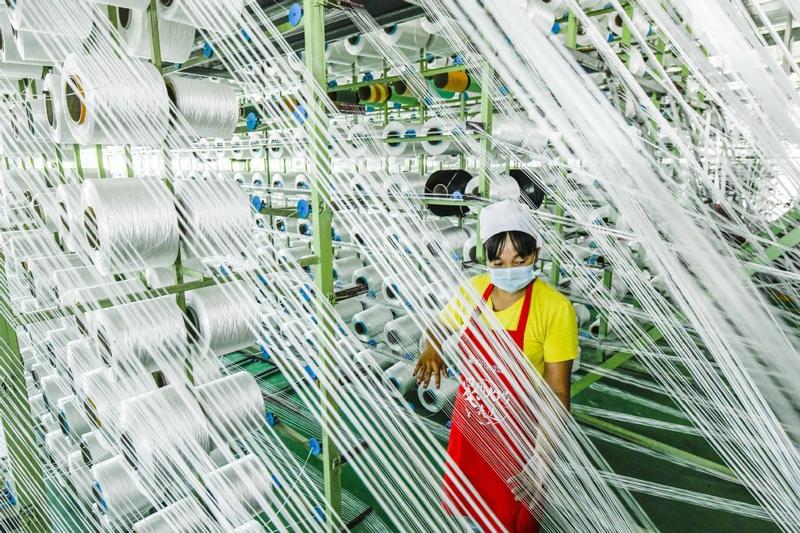 A woman works at a chemical fiber company in Zunhua, Hebei province, on Thursday. China's GDP grew by 3.2 percent year-on-year in the second quarter, compared with a 6.8 percent decline in the first quarter. (LIU MANCANG / XINHUA)
A woman works at a chemical fiber company in Zunhua, Hebei province, on Thursday. China's GDP grew by 3.2 percent year-on-year in the second quarter, compared with a 6.8 percent decline in the first quarter. (LIU MANCANG / XINHUA)
China's growth recovery is set to continue in the second half of the year, and Beijing's policies are expected to focus on narrowing the development gaps amid the rapid and yet uneven rebound to consolidate the economy's long-term resilience, economists said.
They expect the government's main objectives to continue to center around stabilizing employment and ensuring corporate survival while retaining policy room for any shocks generated by the potential resurgence of the COVID-19 pandemic.
While the world is still struggling with the impact of the pandemic, China's economy made a strong bounce-back in the second quarter, beating economists' expectations by growing 3.2 percent from a year earlier.
The economy has recovered well with respect to industrial production while services took a hit in the first half of the year. In the coming months, we will likely see this performance gap narrowing and economic growth accelerating.
Dominik Peschel, Head of the economics unit for the Asian Development Bank's resident mission in China
ALSO READ: China's economic fundamentals 'unharmed' by pandemic
Analysts are now pondering the sustainability of such strong rebound momentum and how China's policy may evolve in the second half of the year to keep its economy on a steady recovery path.
The general view among economists is that China's recovery will continue in the second half but the sequential pace may be slower as the economy continues to face acute challenges such as persisting unemployment pressure and the possibility of the resurgence of the pandemic.
China will need to step up policy support to address some of the uneven patterns behind the strong rebound, economists said. For example, household consumption remained subdued as national retail sales declined 1.8 percent year-on-year in June, and the recovery of the services sector has fallen behind the country's industrial production and construction growth.
"The economy has recovered well with respect to industrial production while services took a hit in the first half of the year. In the coming months, we will likely see this performance gap narrowing and economic growth accelerating," said Dominik Peschel, head of the economics unit for the Asian Development Bank's resident mission in China.
Economists expect that more supportive policies will be rolled out to facilitate a stronger recovery of the services sector and to spur domestic consumption.
READ MORE: Xi voices confidence in China's economy, vows wider opening-up
Peschel said that the resumption of household consumption will play a crucial role in the continuity of China's recovery in the coming months. The prerequisites for domestic consumption to pick up include the avoidance of a second wave of COVID-19, supportive government policies aiming at stabilizing employment and household incomes, and an improvement in consumer sentiment, he added.
Meanwhile, policy efforts should continue to focus on ensuring that businesses-especially small and medium-sized enterprises-obtain sufficient credit at a reasonable interest rate as employment generation and improvements to people's basic livelihoods largely depend on the capacity of businesses to continue employing staff in a challenging economic environment, Peschel added.
Most economists see no imminent reversal of China's overall policy easing stance after a senior official of the National Bureau of Statistics said on Friday that the national economic recovery remains under pressure as the losses caused by the pandemic have not been fully recouped and getting the economy back to normal is still a strenuous task.
Wang Jinbin, deputy dean of the School of Economics at Renmin University of China, said during an online forum on Saturday that China's overall credit supply will likely be kept at a high level in the coming quarters and more fiscal spending can be expected to help the disaster relief effort and reconstruction in the flood-affected southern regions.
Economists said that China's future policy will continue to reflect the central leadership's idea of maintaining its strategic focus and the bottom-line thinking to prevent the country's economy from suffering unexpected damage given the highly uncertain outlook for the global economy.
"We think the continued growth recovery in the second quarter will not reverse the overall policy easing stance in the third quarter as economic activities have yet to fully return to normal, job market pressure persists and growth uncertainties linger," China economists at Swiss bank UBS said.
ALSO READ: How China's GDP can grow by 3% or more this year
But the central leadership may reassess the mix of policy easing in the months to come as China's growth normalizes and external demand recovers, they said.
Yi Gang, governor of the People's Bank of China, the central bank, said recently that the country needs to prevent its supportive financial policy from diminishing incentives and the government needs to pay more attention to the policy's side effects.
The country's financial regulators have been keeping a vigilant eye on the recent rapid rise of asset prices as well as the potential growth of nonperforming loans in the banking sector amid concerns that the rapid buildup of leverage and the potential surge of bad loans could jeopardize the stability of the country's financial system.
Hua Changchun, chief economist at Guotai Jun'an Securities, said that government policy needs to strike a balance between supporting the economic recovery and preventing financial risks and asset bubbles in capital markets.


